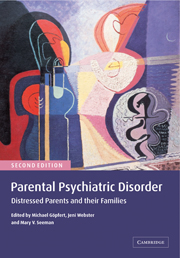Book contents
- Frontmatter
- Contents
- List of contributors
- Foreword
- Preface
- Part I Basic issues
- Part II Comprehensive assessment and treatment
- 6 ‘The same as they treat everybody else’
- 7 Formulation and assessment of parenting
- 8 Mentally ill mothers in the parenting role: clinical management and treatment
- 9 Perinatal mental illness: nature/nurture
- 10 Assessment and treatment issues when parents have personality disorders
- Part III Specific disorders: the impact on parent–child relationships
- Part IV Specific treatments and service needs
- Part V Child-sensitive therapeutic interventions
- Part VI Models for collaborative services and staff training
- Afterword
- Index
- References
8 - Mentally ill mothers in the parenting role: clinical management and treatment
from Part II - Comprehensive assessment and treatment
Published online by Cambridge University Press: 09 August 2009
- Frontmatter
- Contents
- List of contributors
- Foreword
- Preface
- Part I Basic issues
- Part II Comprehensive assessment and treatment
- 6 ‘The same as they treat everybody else’
- 7 Formulation and assessment of parenting
- 8 Mentally ill mothers in the parenting role: clinical management and treatment
- 9 Perinatal mental illness: nature/nurture
- 10 Assessment and treatment issues when parents have personality disorders
- Part III Specific disorders: the impact on parent–child relationships
- Part IV Specific treatments and service needs
- Part V Child-sensitive therapeutic interventions
- Part VI Models for collaborative services and staff training
- Afterword
- Index
- References
Summary
Introduction
When a woman with a major psychiatric disorder becomes a parent, the path that lies ahead for her and her child can be very uncertain. While some mothers are able, despite their illness, to raise their children successfully, as many as 60% of mothers with major mental disorders relinquish or lose custody of their children (Coverdale & Aruffo, 1989; Miller & Finnerty, 1996). Some mothers in this situation provide intermittent parenting or coparenting (Caton et al., 1998) during the years of infancy, childhood and adolescence. Even when mother and child lose contact, each may continue to exert a profound emotional influence over the life of the other (Holley & Holley, 1997).
Intervening to alleviate parenting problems in mothers with major psychiatric disorders is recognized as a challenge to mental health providers (Nicholson & Blanch, 1994). This chapter provides an overview of clinical services and treatments that address serious parenting problems in mothers with major mental illness.
Approach to treatment
Components of a comprehensive evaluation
A comprehensive parenting evaluation is the cornerstone of treatment. It directly examines a mother's ability to read her child's cues, her ability to empathize with and understand the child as an individual, her cognitive understanding of development and childrearing, her ways of coping with stress, her ability to meet basic parenting tasks such as providing food, housing, and safety, and her skill in adjusting her behaviour to meet the changing needs of children as they grow (Jacobsen et al., 1997).
Keywords
- Type
- Chapter
- Information
- Parental Psychiatric DisorderDistressed Parents and their Families, pp. 112 - 122Publisher: Cambridge University PressPrint publication year: 2004
References
- 1
- Cited by



